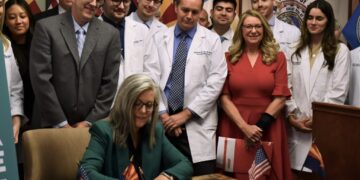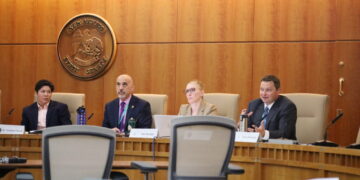Using an often overlooked part of the state constitution that guarantees the right to earn a living, Columbia nurse practitioner Marcy Markes is hoping that challenging the state’s requirement could lead to better health care for Missourians (Meg Cunningham/The Beacon).
In 2020, Marcy Markes was confronted with a harsh reality.
A nurse practitioner who has specialized in allergy and asthma care for more than two decades, she was forced to close three of her rural allergy clinics in central Missouri and consolidate her practice at her clinic in Columbia.
Why? Missouri is one of 11 states that require advanced practice nurses such as Markes to have oversight from a physician.
The rules on how nurse practitioners can see patients in Missouri are meticulous. Nurse practitioners must be within 75 miles of the physician who oversees them on a daily basis, and physicians must sign off on the nurse’s patient records.
When Markes’ overseeing physician got reassigned during COVID and was moved out of the 75-mile radius from her clinics, she had no choice but to close them.
“There was no way I could be at those clinics and be within the mileage of where he was,” Markes said. “So I closed three rural clinics just for specialty care.”
Some of her patients followed her to Columbia, but others lost care.
“You have to take a day off work, or you have the gas money to get here,” Markes said. “It just adds to health care dollars. And it’s not direct … you have to get there first.”
While the rules were designed to keep patients safe, nurses say they don’t do much to improve the care those patients get. In fact, they argue it is a roadblock to Missourians’ access to primary care or mental health providers.
And while advanced practice nurses like nurse practitioners and midwives have been pushing for decades to get the law changed in Missouri, there’s been almost no momentum in the state legislature.
So Markes is suing Missouri.
Using an often overlooked part of the state constitution that guarantees the right to earn a living, Markes is hoping that challenging the state’s requirement could lead to better health care for Missourians.
In states where nurse practitioners can practice individually, overall health ranks were 17 spots higher than in states with reduced practices, like Missouri.
And patient access in states where nurse practitioners can practice independently is higher. States with individual practice rights ranked 19 spots higher than states without when it came to patients’ access to care.
How Missouri’s oversight works
Missouri is one of only 11 states that still require advanced practice nurses to have oversight from a physician, formally called a collaborative practice agreement.
Nearly every Missouri county has been designated a health professional shortage area when it comes to primary care and mental health care. Recent nationwide data shows that 66% of designated shortage areas were in rural parts of the country.
Research also shows that nurse practitioners are more likely to practice in rural communities. Nationwide, 88% of nurse practitioners are certified in primary care, according to the American Association of Nurse Practitioners.
In Missouri, independent physicians can set the rates they charge to nurse practitioners for their time and oversight.
For Markes, who provides speciality care with oversight from a pulmonologist, it is no small cost.
She budgets more than $50,000 annually to pay her collaborating physician, who she said has little impact on how she cares for patients or runs her clinic.
“He’s there when I need him,” Markes said of her overseeing physician. “There can be as much or as little collaboration, depending on who you’re working with.”
By running her own clinic, Markes is in a unique position. She takes on the cost and administrative burden of meeting the legal requirement of physician oversight.
For nurse practitioners who are part of larger health systems, the hospitals assign an overseeing physician and pay them a bonus for their review. But, practitioners say, the review is retroactive, and mostly means additional time spent looking at patient records that could be spent seeing more patients.
“It’s time that could be better spent taking care of your patients, rather than worrying about the collaborative practice agreement,” said Dawn Stout, a family nurse practitioner in Trenton, near the Iowa border.
Nationwide, 27 states allow nurse practitioners to practice to the full extent of the licensing.
There are limits to what nurse practitioners without full authority can do. They have limits in what medicines they can prescribe, making things like mental health care or pain management especially difficult.
“I have issues maintaining good pain control,” Stout said. “I’m limited to a five-day prescription for narcotics, so I have to jump through the hoop of getting my (physician) to sign off on them.”
Ultimately, nurse practitioners say that beyond checking patient care records and the occasional oversight on what can be prescribed to their patients, they usually don’t have much communication with their physicians or oversight from the state.
“I’ve been at this facility almost 15 years,” Stout said. “Nobody has ever come and checked on our charts to see how many are signed by a physician.”
In an email, the Missouri Board of Healing Arts and the state Board of Nursing, which oversee physicians and nurses respectively, said there is no requirement for state boards to verify collaborative practice agreements.
Physicians must report if they have nurse practitioners they oversee. Otherwise, there is no routine interaction between the boards and the nurses and physicians they oversee.
“It’s a retrospective review,” said Donna Matias, an attorney at Pacific Legal Foundation who is representing Markes in her case against the state. “And there is no enforcement of the review. I have talked to plenty of nurse practitioners who have said, ‘I have never even met my collaborating physician.’’’
“What it does signal is that this is not about health and safety,” she said.
In 2024, legislation to eliminate collaborative practice requirements was introduced in the Missouri House of Representatives. The bill would have removed the requirement for nurse practitioners to have an overseeing physician after 2,000 hours of work — less than a year of full-time nursing practice.
Groups like the Missouri Farm Bureau and individual Missouri nurses submitted testimony in support, citing the changes the legislation could make for patient access.
The Missouri State Medical Association, the Missouri Academy of Family Physicians and individual physicians and osteopathic doctors testified against the legislation, arguing that 2,000 hours is not enough time for a nurse practitioner to gain skills. They also argued the bill would degrade the extensive training other medical professionals receive.
“One thing I do like about collaborative practice is I always have a resource at my fingertips if I need something,” Stout said. “But that same resource would be there even without the collaborative practice agreement.”
How could full practice authority change patient access to primary care providers?
Although the number of nurse practitioners is growing in Missouri — the state has 16,715 advanced practice registered nurses, double what it did 10 years ago — nurse practitioners are also taking their skills elsewhere.
Nebraska, Iowa and Kansas have all granted advanced practice nurses full practice authority, while Illinois and Arkansas have granted full authority with a few restrictions.
For Terry Thomas, a nurse practitioner who sees patients in Hannibal, making the move from Nebraska to Missouri after the pandemic was complex.
“It was very difficult going from a state with full practice authority in Nebraska to Missouri, which is one of the most restricted states in the U.S. when it comes to nurse practitioners,” Thomas said.
Usually, Thomas said, nurses near state lines will decide to practice in other states.
Stout, the family nurse practitioner in Trenton, is also licensed to practice in Iowa.
“People I’ve known over the years that are from this area, they’re like, ‘I’m not dealing with the restrictions that Missouri has.’ And they’ll go to a state that doesn’t have collaborative practice because it’s so restrictive,” Stout said.
It’s also becoming more difficult to find a physician to oversee your practice, nurse practitioners say. The number of physicians who practice independently is waning, and taking on the liability of another medical professional’s care is a hard sell.
About 77% of physicians in the U.S. are now employed by hospital systems or corporate entities, up sharply since 2019. In the Midwest, hospital or corporate owned practices have increased nearly 40% since 2019.
Acquisitions of private practices by corporate entities skyrocketed 87% from 2019 to 2023 in the Midwest.
“You start adding in 20, 40, 60 extra charts a week that you have to read through,” Stout said. “Physicians don’t want to take on nurse practitioners because it increases their workloads so much.”
Still, there is a projected shortage of 87,000 primary care physicians nationwide by 2037. And in 2022, more than half of working primary care doctors reported burnout.
A 2018 study used Medicare data to track health outcomes with patients who used nurse practitioners as their primary care providers. The data found those patients had lower rates of hospital admissions or readmissions and lower rates of improper use of the emergency room, compared to patients of primary care medical doctors.
States began passing legislation to allow for full practice authority in the 1990s, beginning with Iowa, Montana, New Mexico, Alaska and Oregon. Currently, 27 states allow full practice authority, while 12 have reduced authority and 11 states still require nurse practitioners to have supervision by a physician.
Ultimately, nurse practitioners know that even with full practice ability, they don’t have the same knowledge and training physicians do. And by suing the state, Markes isn’t trying to ban physician oversight for nurse practitioners.
But she does want to end the state-mandated requirement.
“In rural areas, you need to have access to physicians. Having independent practice means providers who normally would not go into rural areas could see patients there,” Markes said. “That’s where all of this stems from, is the ability to take care of people.”
This article first appeared on Beacon: Missouri and is republished here under a Creative Commons Attribution-NoDerivatives 4.0 International License.![]()
This post was originally authored and published by Meg Cunningham from Missouri Independent via RSS Feed. Join today to get your news feed on Nationwide Report®.


























